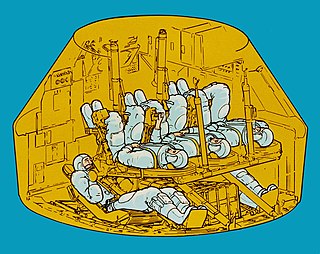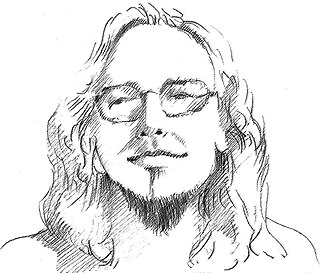
Skylab was the first United States space station, launched by NASA, occupied for about 24 weeks between May 1973 and February 1974. It was operated by three separate three-astronaut crews: Skylab 2, Skylab 3, and Skylab 4. Major operations included an orbital workshop, a solar observatory, Earth observation, and hundreds of experiments.

A space station is a spacecraft capable of supporting a human crew in orbit for an extended period of time, and is therefore a type of space habitat. It lacks major propulsion or landing systems. An orbital station or an orbital space station is an artificial satellite. Stations must have docking ports to allow other spacecraft to dock to transfer crew and supplies. The purpose of maintaining an orbital outpost varies depending on the program. Space stations have most often been launched for scientific purposes, but military launches have also occurred.

Skylab 2 was the first crewed mission to Skylab, the first U.S. orbital space station. The mission was launched on an Apollo command and service module by a Saturn IB rocket on May 25, 1973, and carried NASA astronauts Pete Conrad, Joseph P. Kerwin, Paul J. Weitz to the station. The name Skylab 2 also refers to the vehicle used for that mission. The Skylab 2 mission established a twenty-eight-day record for human spaceflight duration. Furthermore, its crew were the first space station occupants ever to return safely to Earth – the only previous space station occupants, the crew of the 1971 Soyuz 11 mission that had crewed the Salyut 1 station for twenty-four days, died upon reentry due to unexpected cabin depressurization.

Skylab 3 was the second crewed mission to the first American space station, Skylab. The mission began July 28, 1973, with the launch of NASA astronauts Alan Bean, Owen Garriott, and Jack Lousma in the Apollo command and service module on the Saturn IB rocket, and lasted 59 days, 11 hours and 9 minutes. A total of 1,084.7 astronaut-utilization hours were tallied by the Skylab 3 crew performing scientific experiments in the areas of medical activities, solar observations, Earth resources, and other experiments.

The Skylab Rescue Mission was a backup rescue flight as part of a contingency plan for the Skylab space station. It used a modified Apollo Command Module that could be launched with a crew of two and return a crew of five.

Skylab 4 was the third crewed Skylab mission and placed the third and final crew aboard the first American space station.
The Apollo Applications Program (AAP) was created as early as 1966 by NASA headquarters to develop science-based human spaceflight missions using hardware developed for the Apollo program. AAP was the ultimate development of a number of official and unofficial Apollo follow-on projects studied at various NASA labs. However, the AAP's ambitious initial plans became an early casualty when the Johnson Administration declined to support it adequately, partly in order to implement its Great Society set of domestic programs while remaining within a $100 billion budget. Thus, Fiscal Year 1967 ultimately allocated $80 million to the AAP, compared to NASA's preliminary estimates of $450 million necessary to fund a full-scale AAP program for that year, with over $1 billion being required for FY 1968. The AAP eventually led to Skylab, which absorbed much of what had been developed under Apollo Applications.

Voyage is a 1996 hard science fiction novel by British author Stephen Baxter. The book depicts a crewed mission to Mars as it might have been in another timeline, one where John F. Kennedy survived the assassination attempt on him on 22 November 1963. Voyage won a Sidewise Award for Alternate History, and was nominated for the Arthur C. Clarke Award in 1997.
Several planned missions of the Apollo crewed Moon landing program of the 1960s and 1970s were canceled for a variety of reasons, including changes in technical direction, the Apollo 1 fire, hardware delays, and budget limitations. After the landing by Apollo 12, Apollo 20, which would have been the final crewed mission to the Moon, was canceled to allow Skylab to launch as a "dry workshop". The next two missions, Apollos 18 and 19, were later canceled after the Apollo 13 incident and further budget cuts. Two Skylab missions also ended up being canceled. Two complete Saturn Vs ended up going unused and are currently on display in the United States.

The Apollo Telescope Mount, or ATM, was a crewed solar observatory that was a part of Skylab, the first American space station. It could observe the Sun in wavelengths ranging from soft X-rays, ultra-violet, and visible light.

Skylab B was a proposed second US space station similar to Skylab that was planned to be launched by NASA for different purposes, mostly involving the Apollo–Soyuz Test Project, but was canceled due to lack of funding. Two Skylab modules were built in 1970 by McDonnell Douglas for the Skylab program, originally the Apollo Applications Program. The first was launched in 1973 and the other put in storage, while NASA considered how to use the remaining assets from Apollo.

Rogério Tolomei Teixeira, better known by his stage name Rogério Skylab, is a Brazilian singer-songwriter, lyricist, classical guitarist, poet, essayist, record producer, actor and former television presenter. His unique musical style is characterized by minimalism and eclecticism, and his lyrics are permeated by acerbic allusions to popular culture, pessimism, scatology, nihilism and black comedy. Some of his most recognizable compositions are "Motosserra", "Fátima Bernardes Experiência", "Dedo, Língua, Cu e Boceta", "Eu Chupo o Meu Pau" and "Matador de Passarinho".

Skylab II was a space station concept proposed in 2013 by the Advanced Concepts Office of NASA Marshall Space Flight Center, to be located at the Earth-Moon L2 Lagrangian point. Proposed by NASA contractor Brand Griffin, Skylab II would have been constructed as a "wet workshop" using a spent upper-stage hydrogen fuel tank from the Space Launch System (SLS), much as the Skylab was originally planned to be built "wet" from the spent bipropellant tanks of the Saturn S-IVB upper stage. If constructed, Skylab II would have been the first crewed outpost located beyond the orbit of the Moon.

Teleoperator Retrieval System was an uncrewed space tug ordered by NASA in the late 1970s to re-boost Skylab using the Space Shuttle.
Skylab Four may refer to:

SpaceX Crew-3 is the third operational flight of a Crew Dragon spacecraft, and the fourth overall crewed orbital flight of the Commercial Crew Program. The mission successfully launched on 11 November 2021 at 02:03:31 UTC to the International Space Station.












